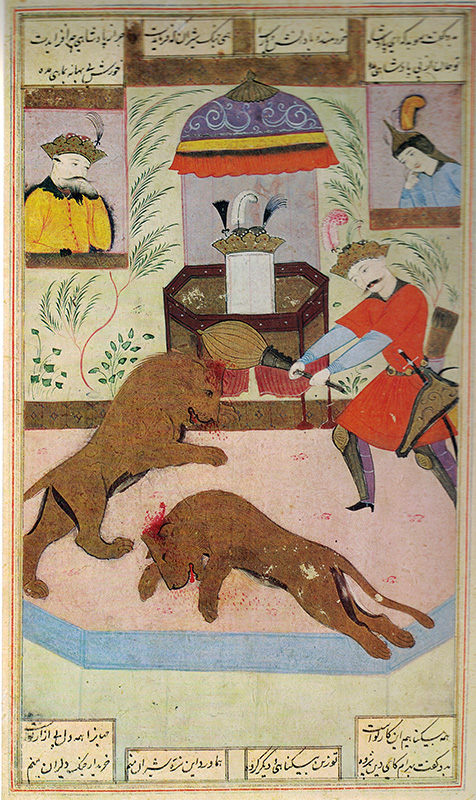Moʿin Moṣavver | Manuscripts | Shahnama of Ferdowsi
Bahrām Gur Snatches the Crown from Between Two Lions
Location: Khalili Collection, London.. Formerly in the Kraus Collection, New York.
Page: 34.5 x 22.3 cm. (after Grube)
Painting: 23.5 x 14.8 cm. (after Grube)
Text area: 23.5 x 14.8 cm.
Signature: not signed.
When Yazdāgerd, son of Šāpur was slain, the Iranians placed a nobleman with no royal lineage named Ḵosrow on the throne. Bahrām, the son of Shah Yazdagerd, was in Yemen where he had been sent as a child to grow up. Upon hearing of his father's death, Bahråm Gur as he ws known, gathered an army and returned to Iran. Both Ḵosrow and Bahrām claimed the kinship, and in order to resolve the dispute, the elders devised a contest: whoever could take the throne which had two lions chained to it would be worthy of being the king. Ḵosrow declined, but Bahrām accepted the challenge. With ox-heded mace in hand, as Bahrām approached the throne, one of the lions charged with such gusto that it broke its chains. Bahrām killed the lion with one mace blow to the head, and then repeated his wrath on the second lion.
Bahråm Gur is portrayed on the right side of the painting wearing a vermilion coat; sword, quivers, and an encased bow hang from his belt. The first lion lies motionless at his feet. With both arms he brings a bulbous mace down on the head of the second lion that has lunged at him from the left. Blood gushes forth from the lion’s head, and it reels from the blow. The throne of Iran, on which is placed the royal crown, appears in the center background under an umrella of state. Behind the throne is a wall with delicately painted representations of green foliage that extends across the entire picture. Two windows are placed in the wall with a single personage appearing in each witnessing the ordeal. In the upper right window is the figure of a young warrior, dressed in a light blue coat and pointed steel helmut to which is affixed a yellow feather. His forefinger is placed at his lip in a sign of astonishment. In the window on the opposite side a distinguished looking man with beard and moustache makes a similar gesture. He is attired in a yellow robe and wears a crown, and might well be Ḵosrow. The foreground, where the ordeal is taking place, is a hexagonal shaped, flat, pink-colored surface that appears to be elevated.
Painting references:
Sothebys London sale catalog, 6 December 1967 page 75 (ill.)
Grube, Kraus, no.163, and color plate XXXVIII.
Text references:
Warner, VI, pp.409-11. Mohl, V, p.440. Levy, p.303.
Photo after Grube
Robert Eng
Last Updated: September 30, 2015 | Originally published: September 30, 2015
Manuscript F, no. 6-410
Location: Khalili Collection, London.. Formerly in the Kraus Collection, New York.
Page: 34.5 x 22.3 cm. (after Grube)
Painting: 23.5 x 14.8 cm. (after Grube)
Text area: 23.5 x 14.8 cm.
Signature: not signed.
When Yazdāgerd, son of Šāpur was slain, the Iranians placed a nobleman with no royal lineage named Ḵosrow on the throne. Bahrām, the son of Shah Yazdagerd, was in Yemen where he had been sent as a child to grow up. Upon hearing of his father's death, Bahråm Gur as he ws known, gathered an army and returned to Iran. Both Ḵosrow and Bahrām claimed the kinship, and in order to resolve the dispute, the elders devised a contest: whoever could take the throne which had two lions chained to it would be worthy of being the king. Ḵosrow declined, but Bahrām accepted the challenge. With ox-heded mace in hand, as Bahrām approached the throne, one of the lions charged with such gusto that it broke its chains. Bahrām killed the lion with one mace blow to the head, and then repeated his wrath on the second lion.
Bahråm Gur is portrayed on the right side of the painting wearing a vermilion coat; sword, quivers, and an encased bow hang from his belt. The first lion lies motionless at his feet. With both arms he brings a bulbous mace down on the head of the second lion that has lunged at him from the left. Blood gushes forth from the lion’s head, and it reels from the blow. The throne of Iran, on which is placed the royal crown, appears in the center background under an umrella of state. Behind the throne is a wall with delicately painted representations of green foliage that extends across the entire picture. Two windows are placed in the wall with a single personage appearing in each witnessing the ordeal. In the upper right window is the figure of a young warrior, dressed in a light blue coat and pointed steel helmut to which is affixed a yellow feather. His forefinger is placed at his lip in a sign of astonishment. In the window on the opposite side a distinguished looking man with beard and moustache makes a similar gesture. He is attired in a yellow robe and wears a crown, and might well be Ḵosrow. The foreground, where the ordeal is taking place, is a hexagonal shaped, flat, pink-colored surface that appears to be elevated.
Painting references:
Sothebys London sale catalog, 6 December 1967 page 75 (ill.)
Grube, Kraus, no.163, and color plate XXXVIII.
Text references:
Warner, VI, pp.409-11. Mohl, V, p.440. Levy, p.303.
Photo after Grube
Robert Eng
Last Updated: September 30, 2015 | Originally published: September 30, 2015
